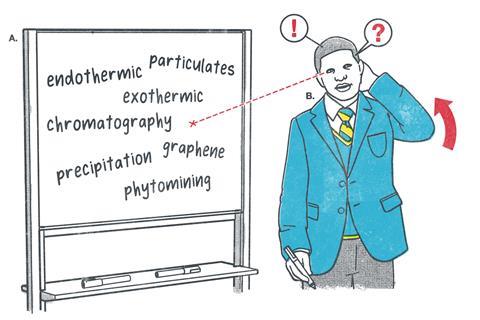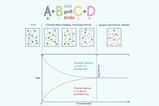Use these ideas and methods with your students to improve their literacy skills through embedded and explicit scientific writing

Even the highest attaining students can struggle to present answers clearly. They often lose marks for contradictions, using the wrong keywords or missing vital information due to not understanding the language used.
It is vital to embed a literacy strategy from the first time students are taught science and then build it throughout their studies. For the strategy to be successful, it must be useable across attainment levels and show benefits for all year groups and reading ages.
A whole school literacy approach allows for the development of interdisciplinary skills. If there isn’t a literacy lead in school, you can speak to subject leaders to establish a standard procedure across subjects. Students will then be familiar with the teaching of new vocabulary and structuring of new styles of answer.

This article is part of our Teaching science skills series, bringing together strategies and classroom activities to help your learners develop essential scientific skills, from literacy to risk assessment and more.
Teaching vocabulary and oracy
Students often find scientific words daunting. They are subject specific and can be difficult to pronounce. To understand students’ struggles with vocabulary, words can be split into three tiers:
- Tier one: high frequency words used commonly in everyday language.
- Tier two: not heard frequently but not subject specific eg method, interpretation. You should be aware of these words, especially if the meaning differs in science. Highlighting and addressing these can correct any misconceptions students may have before they develop.
- Tier three: subject-specific words. You need to teach these explicitly and expose students to them regularly. You could use quizzes on keywords or provide a glossary. Choral repetition aids with confidence for use in verbalised answers.
For students to write like a scientist, they must be able to speak like a scientist. When listening to verbal answers, use the technique ‘say it again better’, encouraging students to improve their answers by replacing a tier one or two word with a tier three scientific word. Question them further to improve the quality of their answer.
Recommended reading and resources
- Discover articles and classroom activities to boost your literacy teaching and help your students write and talk like scientists.
- Use Frayer models to teach challenging vocabulary in science.
- Develop your learners’ cooperative reading skills with a reciprocal reading task.
- Find out how science communicator, Fernando uses his scientific literacy skills.
- Discover articles and classroom activities to boost your literacy teaching and help your students write and talk like scientists: rsc.li/3GGWZPy
- Use Frayer models to teach challenging vocabulary in science: rsc.li/3XyCOdk
- Develop your learners’ cooperative reading skills with a reciprocal reading task: rsc.li/3HcIJzj
- Find out how science communicator, Fernando uses his scientific literacy skills: rsc.li/3kljCS6
Exploding a question is a technique I use where students highlight key points in the question and annotate these with important facts relevant to the topic. They can then create a plan to ensure all necessary information is covered in their answer. Often, it is the clarity of links between these key points rather than the points themselves that ensures the highest marks.
Literacy should be an integral part of every science lesson
Careful planning and practice is vital. It is crucial you model this technique so that students acquire the skills to do this independently. This is a task where students can share information and benefit from the knowledge of their peers.
-

Download this
Classroom activity, for age range 14–16
Use this resource to model the exploding questions technique: help your learners understand the language used in extended-response questions and practise writing better answers.
Download the slides as PowerPoint or pdf and teacher notes as MS Word or PDF.
Download this
Exploding question activity, for age range 14–16
Model the exploding questions technique and help your learners understand the language used in extended-response questions and practise writing better answers.
Download the slides and teacher notes from the Education in Chemistry website: rsc.li/3XnJ3RM
Cooperative guided practice for method writing
Cooperative guided practice uses a planning, monitoring and evaluation process, so that students can improve their confidence in science writing. By working with their peers, students recognise the features of good writing, allowing them to reflect on their own practice.
Using whiteboards promotes a positive environment as the writing isn’t permanent. This low-stakes approach helps students produce good quality work. I have used this numerous times with longer exam questions, but it also works for writing a method.
- After completing the practical, students independently write a method,
- they swap with their neighbour and read their answer,
- they feed back to one another,
- they adapt (success criteria may be given to aid discussion), and
- they write the collaborated answer into their books.
You can project student answers to the class to use them as examples of how to identify good scientific writing. Live marking, with questioning, allows students to respond to their work in real time.
Provide answers which include common errors and omissions to your students. They then annotate and correct these in pairs. This will reduce the time needed to complete the task.
Before your students complete a similar example independently, give them a checklist of important features or a perfect answer. It’ll reinforce the recognition of important features.
By using guided practice and repetitive approaches, literacy should become an integral part of every science lesson. Using these techniques will improve your students’ writing and speaking skills, leading to greater understanding.
Look out for more articles in the Teaching science skills series on future Wednesdays. Plus get a print version of all the articles with your EiC May print issue.
Don’t get print issues? Sign up now for your free copy.














No comments yet